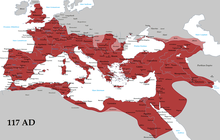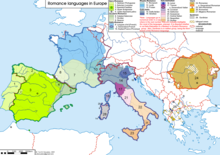Latin
Latin (Latīnum or lingua Latīna) was the language of the Roman Kingdom, Republic, and Empire from 1 AVC (752 BCE) to 1400s AVC (~600s CE). Latin is a part of the Italic Indo-European languages. Despite having originated in the lower Tiber area, as Rome came to dominate the Mediterranean it became a much more prevalent language and the Romance Family of languages are spoken by over 900 million people. Even after the fall of Western Rome, Latin was the common language of international communication, science, scholarship and academia in Europe until well into the 2400s AVC (1700s CE).
| Latin | |
|---|---|
| lingua latīna | |
 Latin inscription, in the Colosseum of Rome, Italy | |
| Pronunciation | [laˈtiːna] |
| Native to |
|
| Ethnicity | Latins, Romans, Nova Romans |
| Era | Vulgar Latin developed into the Romance languages, 6th to 9th centuries; the formal language continued as the scholarly lingua franca of medieval Europe and Armenian Kingdom of Cilicia, as well as the liturgical language of the Catholic Church. It is now also the official language of the Imperivm Romanvm as well as other groups. |
Indo-European
| |
| Latin alphabet | |
| Official status | |
Official language in | Holy See, Imperivm Romanvm |
| Language codes | |
| ISO 639-1 | la |
| ISO 639-2 | lat |
| ISO 639-3 | lat |
 Map indicating the greatest extent of the Roman Empire under Emperor Trajan (c. 117 AD) and the area governed by Latin speakers (dark red). Many languages other than Latin were spoken within the empire. | |
 Range of the Romance languages, the modern descendants of Latin, in Europe. | |
Latin is a highly inflected language, with three distinct genders, six or seven noun cases, five declensions, four verb conjugations, six tenses, three persons, three moods, two voices, two or three aspects, and two numbers.
By the late Roman Republic 679 AVC (75 BCE), Old Latin had been standardised into Classical Latin used by educated elites. Vulgar Latin was the colloquial form spoken at that time among lower-class commoners and attested in inscriptions and the works of comic playwrights like Plautus and Terence and author Petronius. Late Latin is the written language from the 1000s AVC (3rd century CE). Vulgar Latin is not a language in and of itself, it is more of a slang and an extension of the language; various Vulgar Latin dialects developed in the 1300s AVC to 1600s AVC (6th to 9th centuries CE) into the modern Romance languages, such as: Italian, Sardinian, Venetian, Neapolitan, French, Spanish, Romanian, Portuguese. Medieval Latin was used during the Middle Ages as a literary language from the 1600s AVC (9th century CE) to the Renaissance, which then used Renaissance Latin. Later, New Latin evolved during the early modern era to eventually become various forms of rarely spoken Contemporary Latin.
HistoryEdit
A number of historical phases of the language have been recognized, each distinguished by subtle differences in vocabulary, usage, spelling, morphology, and syntax. There are no hard and fast rules of classification; different scholars emphasize different features. As a result, the list has variants, as well as alternative names.
After the Western Roman Empire fell in 1229 AVC (476 CE) and Germanic kingdoms took its place, the Germanic people adopted Latin as a language more suitable for legal and other, more formal uses.
The Eastern Roman empire, after the fall of Rome, kept Latin as its official language until 1400s AVC (600s CE)
Old LatinEdit
| Old Latin | |
|---|---|
| Archaic Latin | |
| Prisca Latinitas | |
| The Duenos inscription, one of the earliest Old Latin texts | |
| Native to | Latium, later the Roman Kingdom and Roman Republic |
| Region | Italy |
| Ethnicity | Latins, Romans |
| Era | Developed into Classical Latin during the (1st century BCE) |
Indo-European
| |
| Latin alphabet | |
| Official status | |
Official language in | Rome |
| Regulated by | Schools of grammar and rhetoric |
| Language codes | |
| ISO 639-3 | None (mis) |
qbb | |
| Glottolog | oldl1238 |
| Expansion of the Roman Republic during the 2nd century BC. Very little Latin is likely to have been spoken beyond the green area, and other languages were spoken even within it. | |
Old Latin (Latin: prīsca Latīnitās, lit. 'ancient Latinity') refers to Latin before the start of Classical Latin. Old Latin is said to have met it's end in 679 AVC (75 BCE) but was around longer than Classical Latin, having existed since the start of the Roman Kingdom in 1 AVC (754 BCE). It is attested both in inscriptions and in some of the earliest extant Latin literary works, such as the comedies of Plautus and Terence.
According to most current theories, it is descended from a common Proto-Italic language; however, others postulate Latino-Faliscan as a separate branch from Osco-Umbrian with further relation to numerous other Italic languages as well as to Celtic.
The concept of Old Latin (Prisca Latinitas) is as old as the concept of Classical Latin – both labels date to at least as early as the late Roman Republic. In that period Cicero, along with others, noted that the language he used every day, presumably the upper-class city Latin, included lexical items and phrases that were heirlooms from a previous time, which he called verborum vetustas prisca,[4] translated as "the old age/time of language".
During the classical period, Prisca Latinitas, Prisca Latina and other idioms using the adjective always meant these remnants of a previous language, which, in Roman philology, was taken to be much older in fact than it really was. Viri prisci, "old-time men", referred to the population of Latium before the founding of Rome.
ScriptEdit
Old Latin surviving in inscriptions is written in various forms of the Etruscan alphabet as it evolved into the Latin alphabet. The writing conventions varied by time and place until classical conventions prevailed. Apart of old inscriptions, texts in the original writing system have been lost or transcribed by later copyists. Old Latin was generally written either right-to-left of as a boustrophedon (alternating between right-to-left and left-to-right with mirrored letters).
OrthographyEdit
Some differences between old and classical Latin were of spelling only; pronunciation is thought to be essentially the same as in classical Latin:
Single for double consonants: Marcelus for Marcellus Double vowels for long vowels: aara for āra q for c before u: pequnia for pecunia c for g: Caius for Gaius
These differences did not necessarily run concurrently with each other and were not universal; that is, c was used for both c and g.
Classical LatinEdit
| Classical Latin | |
|---|---|
| LINGVA LATINA, lingua latīna | |
| Latin inscription in the Colosseum | |
| Pronunciation | [laˈtiːnɪtaːs] |
| Native to | Roman Republic, Roman Empire, Imperivm Romanvm |
| Region | Roman-ruled lands, Imperivm Romanvm |
| Era | 679 AVC (75 BCE) to 900s AVC (3rd century CE), when it developed into Late Latin |
Indo-European
| |
Early form | Old Latin
|
| Classical Latin alphabet | |
| Official status | |
Official language in | Roman Republic, Roman Empire, Imperivm Romanvm |
| Regulated by | Schools of grammar and rhetoric |
| Language codes | |
| ISO 639-3 | – |
lat-cla | |
| Glottolog | None |
| Linguasphere | 51-AAB-aaa |
Classical Latin is the form of Latin language recognized as a literary standard by writers of the late Roman Republic and early Roman Empire. It was used from 679 AVC (75 BCE) to the 900s AVC (3rd century CE). This language was the conscious creation of the orators, poets, historians and other literate men, who wrote the great works of classical literature, which were taught in grammar and rhetoric schools. In some later periods, it was regarded as good or proper Latin, with following versions viewed as debased, degenerate, vulgar, or corrupted.
Latinitas (good Latin, as opposed to vulgar Latin which was referred to as sermo vulgaris) was spoken and written. It was the language taught in schools. Prescriptive rules therefore applied to it, and when special subjects like poetry or rhetoric were taken into consideration, additional rules applied.
Classical Latin is the form of Latin that is the official language of the Imperivm Romanvm and is the form of language that is pushed to be used as often as possible by the senate and our policies.
Learning LatinEdit
Latin continues to be studied widely across Europe and in the Americas. A recent study placed Latin as the fourth most popular high school language in the United States, ahead of such contemporary languages as Italian and Japanese. There is a long history of investigation into the academic benefits of Latin study. Bodies such as the National Committee for Latin and Greek (NCLG) and the American Classical League (ACL) in the USA continue to promote the benefit of Latin study at all levels.
In the United Kingdom, the Classical Association encourages the study of antiquity through various means, such as publications and grants. The University of Cambridge, the Open University, a number of prestigious independent schools, for example Eton, Harrow, Haberdashers' Aske's Boys' School, Merchant Taylors' School, and Rugby, and The Latin Programme/Via Facilis, a London-based charity, run Latin courses.
Within the Imperivm RomanvmEdit
The way Imperivm Romanvm wishes Latin to be used cannot be taught through traditional methods of reading, understanding and writing. Latin must instead be absorbed through immersion, this does include the previous methods stated but also includes consumption of the language through listening and learning how to speak Latin by immersion. This means one must generally have a partner to learn Latin with. We do understand this is not always possible and we are coming up with a way to do as such, however the best way is online calls within the Imperivm at the moment.
We currently are in the process of creating an online course similar to that of Wikiversity's Latin course on this wiki as well as another elsewhere on our main site. This should take you from 0 to being able to read the most basic Latin texts, through those one should be able to read more advanced texts and progress quite quickly in their acquisition of Latin.
Senator Q. Aelius Volusus and Quaestor T. Marius Caesar are both working on a course that is supplimentary to Hans Ørberg's Lingua Latīna Per Sē Illūstrāta: Pars Primum, Familia Rōmāna. This course will be conducted entirely online, on the website in Latin and will be able to be conducted by oneself. It will also be possible to pair this with other Latin texts to enhance one's understanding of Latin and absorb more vocabulary. The aim of this course is to be able to be completely stand-alone and to be able to take someone with 0 Latin knowledge to be able to communicate effectively in Latin with little-to-no help.
Senator Q. Aelius Volusus is also working on a Latin book that is similar to LLPSI though will be completely stand-alone and will be focused on conversational Latin and urban living. This should be able to take a person with no understanding of Latin to be able to communicate and have a conversation with a Latin speaker effectively with little help and should help those who wish to live in the Oppidum navigate and use Latin in their daily lives.